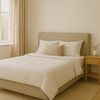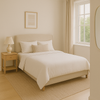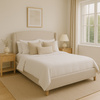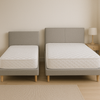How Often Should You Replace Your Bed or Mattress? The Definitive Lifespan Guide
- by Mariam Labadze
Quick Answer
Replace mattresses every 7-10 years for quality models, sooner for budget options (5-7 years) or if experiencing noticeable deterioration regardless of age. Key replacement indicators include visible sagging exceeding 2-3cm depth, waking with persistent back or neck pain not present previously, allergies worsening from dust mite accumulation, partner disturbance increasing from worn springs losing motion isolation, or simply sleeping better in hotels or guest beds than your own. Bed frames and bases last 15-25+ years for quality wood or metal construction, though divan bases require replacement every 10-12 years due to spring deterioration. Mattress type affects lifespan: pocket sprung (8-10 years), memory foam (7-10 years), hybrid (8-12 years), latex (10-15 years). Proper maintenance including regular rotation, quality protectors, and appropriate support bases extends lifespans by 2-3 years whilst delaying replacement wastes money on poor sleep quality and potential health impacts that new mattresses would resolve.
Standard Mattress Lifespan by Type
Pocket Sprung Mattresses (8-10 Years) – Quality pocket sprung mattresses using individual fabric-encased springs typically deliver 8-10 years comfortable support before spring fatigue and comfort layer compression necessitate replacement. The individual springs maintain independence longer than traditional open coil designs, providing consistent support throughout reasonable lifespans.
Premium pocket sprung mattresses featuring higher spring counts (2000-3000+ in king size), quality comfort layers, and robust construction can reach 10-12 years, whilst budget alternatives using fewer springs (800-1000) and basic materials deteriorate within 5-7 years regardless of careful use.
Signs of pocket sprung deterioration include squeaking from worn springs, visible body impressions where you regularly sleep, and that distinctive "rolling together" feeling in couples' beds as worn center springs lose resistance allowing both partners sagging toward middle regardless of edge positioning.
Memory Foam Mattresses (7-10 Years) – Quality memory foam using high-density materials (50kg/m³ or higher) maintains supportive properties for 7-10 years, though cheaper lower-density foams (less than 40kg/m³) lose supportiveness within 5-6 years as cell structure breaks down from repeated compression.
Memory foam longevity depends heavily on density and manufacturing quality—premium foams recover completely from compression thousands of times, whilst budget alternatives develop permanent impressions within 2-3 years where bodies regularly rest. These permanent depressions indicate foam cell collapse that no amount of flipping or rotating can remedy.
Temperature sensitivity means memory foam mattresses in warm bedrooms or used by naturally hot sleepers may deteriorate faster than those in cooler environments, as heat accelerates foam breakdown through increased molecular activity and oxidation.
Hybrid Mattresses (8-12 Years) – Combining pocket springs with foam or latex comfort layers, quality hybrids typically outlast pure foam mattresses through spring resilience whilst exceeding basic pocket sprung longevity through superior comfort layer engineering. The best hybrids feature premium materials in both spring and comfort components, justifying 10-12 year expectations.
However, hybrid quality varies enormously. Budget hybrids sometimes combine mediocre springs with thin foam layers creating mattresses failing within 5-6 years—the hybrid construction alone doesn't guarantee longevity without quality materials throughout all components.
Natural Latex Mattresses (10-15 Years) – Natural latex represents the most durable mattress material, with quality examples maintaining supportive properties for 10-15 years through inherent resilience that synthetic foams and springs cannot match. The material's natural elasticity allows recovering from compression indefinitely when properly formulated and manufactured.
This exceptional longevity justifies latex's premium pricing (typically 30-50% more than equivalent-quality pocket sprung or memory foam). The cost-per-year over extended lifespans often proves competitive with or superior to cheaper alternatives requiring more frequent replacement.
Synthetic or blended latex mattresses offer shorter lifespans (7-10 years) more comparable to memory foam, though still exceeding budget mattress longevity through better material resilience than purely synthetic alternatives.
Budget and Open Coil Mattresses (5-7 Years) – Economy mattresses using open coil springs (where all springs connect as single unit) and basic comfort layers typically require replacement after 5-7 years as the continuous spring system loses tension uniformly, creating sagging that individual pocket springs resist longer through independent operation.
Budget memory foam and basic foam mattresses in this price category similarly deteriorate within 5-7 years, with visible body impressions, loss of edge support, and general comfort decline making continued use uncomfortable regardless of technically remaining "functional."
Bed Frame and Base Longevity
Wooden Bed Frames (15-25+ Years) – Quality solid wood frames using hardwoods (oak, walnut, beech) and proper joinery (mortise-and-tenon, dovetails, reinforced screws) last 15-25+ years with basic maintenance. The robust construction supports mattress weight and occupant movement through decades of nightly use without structural compromise.
Pine or softer wood frames show wear sooner (10-15 years) through denting, joint loosening, or slat warping, though proper maintenance and periodic tightening extends usable lifespans. Particle board or MDF frames rarely exceed 8-10 years before structural deterioration necessitates replacement regardless of surface appearance.
Aesthetic changes sometimes motivate replacement before structural necessity—design preferences evolve, homes change, and 15-year-old furniture feels dated despite remaining perfectly functional. This represents personal choice rather than genuine replacement need from frame deterioration.
Metal Bed Frames (20-30+ Years) – Steel or wrought iron frames properly protected from rust essentially last indefinitely from structural perspective. The metal construction resists the joint loosening, warping, or material fatigue that wood experiences, making metal frames excellent long-term investments when aesthetics suit personal preferences.
Joints may require occasional tightening as repeated assembly and movement loosens bolts, but proper maintenance keeps metal frames functional far beyond mattress lifespans. Paint or powder coat finishes might deteriorate before structure fails, though refinishing proves straightforward restoring appearance without replacement.
Upholstered Bed Frames (12-18 Years) – Fabric or leather-covered frames typically require replacement within 12-18 years as upholstery shows wear, staining, or fabric deterioration even when underlying structures remain sound. The visible degradation makes beds appear shabby regardless of continued function.
However, quality upholstered frames can be reupholstered (costing £300-£600 typically) if structures remain solid, extending total lifespans to 20+ years through fabric renewal that costs significantly less than complete replacement whilst eliminating unnecessary furniture waste.
Divan Bases (10-12 Years) – Platform divan bases with integrated springs require replacement every 10-12 years as internal springs fatigue similarly to mattresses. The spring deterioration undermines even new mattresses placed atop worn bases, making divan replacement necessary when mattress replacement occurs if bases exceed 8-10 years age.
Solid platform divans without springs last considerably longer (15-20+ years) as the solid construction doesn't deteriorate beyond cosmetic wear that rarely warrants replacement. These prove superior long-term investments despite often costing more initially than sprung alternatives.
Signs You Need Immediate Replacement
Visible Sagging and Body Impressions – Mattress depressions exceeding 2-3cm depth measured from surrounding surface to lowest point indicate structural failure regardless of mattress age. These impressions prevent proper spinal alignment, causing back pain and poor sleep quality that worsens progressively as sagging increases.
Test sagging by placing a straight edge (yardstick or spirit level) across mattress surfaces at body positions. Measure gaps beneath—anything exceeding 3cm requires replacement. Some manufacturers specify warranty thresholds at 3.5-4cm, but comfort deteriorates long before reaching these arbitrary coverage limits.
Visible body impressions—permanent indentations showing where you regularly sleep—indicate the comfort layer and/or support core has failed permanently. No amount of rotation or flipping resolves this structural deterioration that only replacement addresses adequately.
Persistent Physical Discomfort – Waking with back, neck, or shoulder pain that improves throughout the day but returns after each night's sleep strongly suggests mattress inadequacy. If you sleep better in hotels, guest beds, or even sofas than your own bed, replacement should prove immediate priority rather than dismissed as minor concern.
Increased partner disturbance—rolling together, feeling every movement your partner makes, or waking when they shift positions—indicates motion isolation failure from worn springs or degraded foam. This deterioration progressively worsens sleep quality for both partners regardless of who moves more frequently.
Allergy and Hygiene Issues – Worsening allergies, increased morning congestion, or respiratory issues potentially indicate excessive dust mite accumulation that cleaning cannot adequately address. Mattresses accumulate dead skin cells, dust mites, and allergens throughout lifespans regardless of protector use, with concentrations increasing annually.
After 8-10 years, even well-maintained mattresses contain millions of dust mites feeding on accumulated skin cells. This biological reality makes replacement prudent from health perspective even when comfort remains technically adequate—the hygiene concerns alone justify periodic replacement.
Age Exceeding Manufacturer Recommendations – If mattresses exceed 10 years regardless of subjective comfort, consider replacement proactively. Comfort deteriorates so gradually that you may not notice incremental decline from nightly sleeping, whilst guests or hotel beds suddenly reveal what quality sleep actually feels like compared to your gradual comfort compromise.
The "boiling frog" syndrome—gradual deterioration going unnoticed until suddenly obvious—affects many sleepers who've adjusted unconsciously to declining mattress quality over years. If you cannot remember last sleeping truly well, replacement probably overdue regardless of technical assessments.
Factors Accelerating Replacement Needs
Body Weight and Sleep Position – Heavier individuals (over 95kg) compress mattresses more forcefully, accelerating wear particularly in memory foam and budget pocket sprung mattresses not designed for higher weight capacity. Expect 20-30% shorter lifespans than manufacturer estimates based on average 75-80kg users.
Side sleepers concentrate weight on smaller surface areas (shoulders and hips) creating localized wear that back or stomach sleepers' distributed weight avoids. This concentrated pressure develops body impressions faster, potentially warranting replacement 1-2 years sooner than back sleepers experience with identical mattresses.
Sleep Partnerships and Weight Differentials – Two people versus one obviously doubles mattress use and weight load, reducing lifespans proportionally. Couples should expect lifespans at lower end of manufacturer ranges—an 8-10 year mattress might deliver 8 years for couples versus 10 years for solo sleepers.
Significant weight differences between partners (more than 30kg) create uneven wear patterns where heavier partner's side deteriorates faster, causing couples "rolling together" as worn side sags disproportionately. This asymmetric deterioration sometimes necessitates replacement earlier than even-wear scenarios affecting both sides equally.
Children and Pets – Children jumping on beds, pets sleeping on mattresses, or general household activity beyond pure sleeping dramatically accelerates wear. Mattresses in children's rooms or those accommodating pets may require replacement 2-3 years sooner than adult-only, pet-free equivalents.
If children or pets regularly use beds, budget-conscious buyers might actually prefer mid-grade mattresses (5-7 year lifespan) over premium options (8-10 years), as the accelerated wear from non-sleeping use means premium longevity advantages never materialize before replacement becomes necessary anyway.
Maintenance Quality – Proper rotation (every 3 months), quality waterproof protectors preventing moisture damage, and appropriate support bases dramatically extend mattress lifespans. Well-maintained mattresses routinely exceed manufacturer estimates, whilst neglected examples fail prematurely despite quality construction.
Lack of mattress protectors allows accumulated moisture, staining, and accelerated dust mite proliferation—these hygiene and moisture issues deteriorate materials faster whilst creating replacement necessity from cleanliness perspective even if structural integrity remains adequate.
Extending Mattress Lifespan Strategically
Regular Rotation Protocol – Rotate mattresses head-to-foot every 3 months, or at minimum twice annually. This even distribution of wear prevents concentrated deterioration in single areas, extending overall lifespans by 2-3 years through simple maintenance requiring minimal effort.
Modern mattresses rarely require flipping given single-sided designs, though verify manufacturer recommendations as some double-sided models benefit from both rotation and flipping creating four distinct surface positions usable throughout lifespans.
Set calendar reminders or tie rotation to seasonal changes (solstices and equinoxes) creating memorable schedules that consistently maintain rather than forgotten good intentions that sporadic maintenance represents.
Quality Mattress Protectors – Waterproof, breathable protectors (£30-£60 for quality options) prevent moisture damage from spills, perspiration, or accidents whilst blocking dust mites and allergens. This protection proves essential for longevity—unprotected mattresses absorb moisture accelerating material breakdown whilst accumulating contaminants that protected versions avoid.
Wash protectors monthly or quarterly maintaining hygiene whilst protecting underlying mattresses. The modest investment and minimal maintenance effort returns disproportionate value through extended mattress life and superior hygiene throughout ownership periods.
Appropriate Support Systems – Mattresses require proper support bases—divans, slatted frames with adequate spacing (under 8cm gaps), or platform beds providing even support. Inadequate or worn bases cause premature mattress failure regardless of mattress quality, voiding warranties whilst creating unnecessary replacement expenses.
Replace worn divan bases when replacing mattresses—the £200-£400 base investment protects £600-£1200 mattress purchases whilst ensuring optimal performance throughout mattress lifespans that inadequate bases would otherwise compromise.
When to Replace Despite Remaining Lifespan
Life Changes and Needs Evolution – Relationships beginning or ending, health issues developing, or simply changing preferences sometimes warrant replacement despite mattresses remaining within normal lifespans. Don't suffer inadequate mattresses because age suggests they "should" remain serviceable—comfort and health trump arbitrary timelines.
Weight changes exceeding 10kg significantly alter mattress support appropriateness. Firmness that suited 75kg you proves too soft after reaching 90kg, or too firm after losing weight to 65kg. These changes justify replacement proactively rather than enduring inappropriate support damaging sleep quality and physical health.
Technological Advances – Mattress technology improves continuously. Premium mattresses from 2015 perform acceptably but lack pressure relief, cooling, or motion isolation that 2025 technology provides routinely even at mid-market price points. If your mattress predates significant technological improvements relevant to your needs, replacement proves worthwhile despite remaining functional.
Sleep Quality Priorities Shifting – Perhaps sleep quality never seemed priority during demanding career phases or young parenthood. As life circumstances change and quality sleep becomes valued differently, replacing adequate mattresses with excellent options proves entirely rational—sleep health affects every life aspect, justifying investments in optimal rather than merely acceptable sleeping conditions.
At Moorcroft Beds, we help customers understanding when replacement makes sense rather than pushing unnecessary purchases. Our team provides honest assessments about mattress conditions and remaining useful life, ensuring customers replace when genuinely beneficial rather than prematurely discarding serviceable mattresses or continuing with genuinely deteriorated options undermining sleep quality and health.




